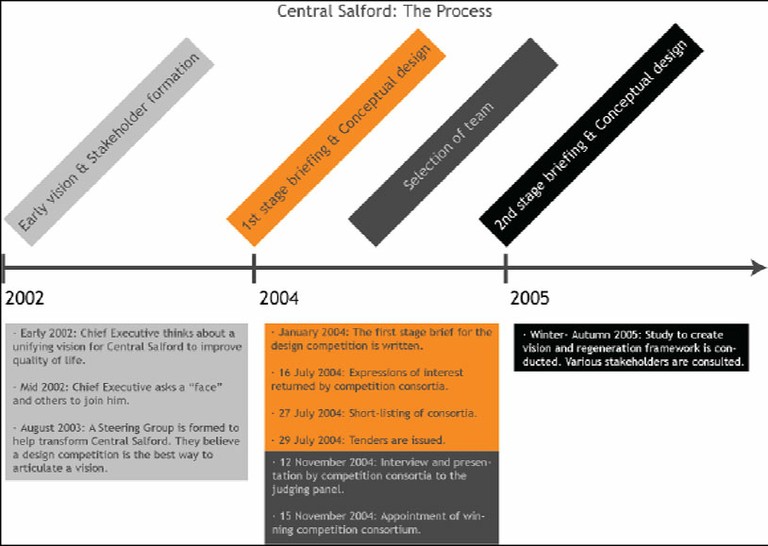Case Study: Central Salford
 In 2002, Central
Salford was what could be described as a deprived area, with high
levels of unemployment, fear of crime, poor family structures and many more
issues. This prompted a regeneration initiative from a number of stakeholders, including Salford City Council, English Partnerships, the University of Salford, local residents and the North
West Development Agency. Despite the deprivation of the area, Salford has a number of advantages and much potential. It
is close to Manchester City Centre, has a river and open green spaces, provides
easy access to a number of transport links, employment opportunities,
universities in both Salford and Manchester,
and a strong local community.
In 2002, Central
Salford was what could be described as a deprived area, with high
levels of unemployment, fear of crime, poor family structures and many more
issues. This prompted a regeneration initiative from a number of stakeholders, including Salford City Council, English Partnerships, the University of Salford, local residents and the North
West Development Agency. Despite the deprivation of the area, Salford has a number of advantages and much potential. It
is close to Manchester City Centre, has a river and open green spaces, provides
easy access to a number of transport links, employment opportunities,
universities in both Salford and Manchester,
and a strong local community.
Method
VivaCity2020 looked at the early stages of the urban design decision-making process followed by the stakeholders and decision-makers at the heart of the Salford regeneration. The background of the area was taken into account, along with a time line of decisions and activities throughout the regeneration process. Researchers examined the urban design decision-making process of the regeneration itself.
Between August 2004 and June 2005, VivaCity2020 undertook a programme of research centred around Salford and the regeneration. Interviews were conducted with Salford City Council and the Central Salford Shadow Board, who became the Urban Regeneration Company. Minutes and reports from Salford City Council were examined, along with design briefs from the Central Salford Shadow Board. A detailed timeline was produced, outlining the regeneration process in detail. This can be found in greater detail in the Case Study Document.
Urban Design Decision-Making
VivaCity2020 found that the regeneration of Salford did follow a process of decision-making which didn’t adhere to specific prescribed tasks and stages. The decision-makers examined policies and reports, consulting stakeholders, professionals and members of the local community for opinions and information.
The decision-making process was found to follow five stages:
1) Early vision, stakeholder formation and project preparation
At the beginning of 2002 the regeneration began. A steering group was formed and the goals of the project were developed. The constraints of the project were identified, along with a project leader, team, values, methods, stakeholders and a holistic design approach.
2) First stage briefing, Vision Development
Stakeholder formation and group discussions about urban design and regeneration took place. Past urban design projects were consulted.
3) Selection of team
An exhibition of the consortia visions took place, and according to prearranged criteria a winner was selected to undertake the regeneration project.
4) Second stage briefing and conceptual design
Preparations for the project began, including forming the right team for the conceptual design, ensuring that the team share the same value system for the project and developing a holistic conceptual design, along with identifying the key stakeholders.
VivaCity2020 then compared the Central Salford urban design decision-making process with
a generic decision-making process created by VivaCity from literature reviews.
Sustainability
It was found that sustainability was not discussed explicitly by decision-makers or stakeholders. Although it is mentioned, detailed consideration of sustainability issues was lacking in the Central Salford regeneration, neglecting issues such as crime, environmental quality, housing, health and transport.
Conclusions
VivaCity2020 found that no prescribed process of decision-making was followed in the regeneration of Salford, but that the processes unfolded naturally through the development of the project. Researchers recognised a gap in the provision of tools and resources to support sustainable and socially responsible urban decision decision-making which VivaCity has now sought to fill.
![]() Click here for a full copy of the Central Salford case study (Microsoft Word document, 1.4mb)
Click here for a full copy of the Central Salford case study (Microsoft Word document, 1.4mb)![]() Back to Case Studies
Back to Case Studies
© Images Copyright Andrew Wooton 2008

